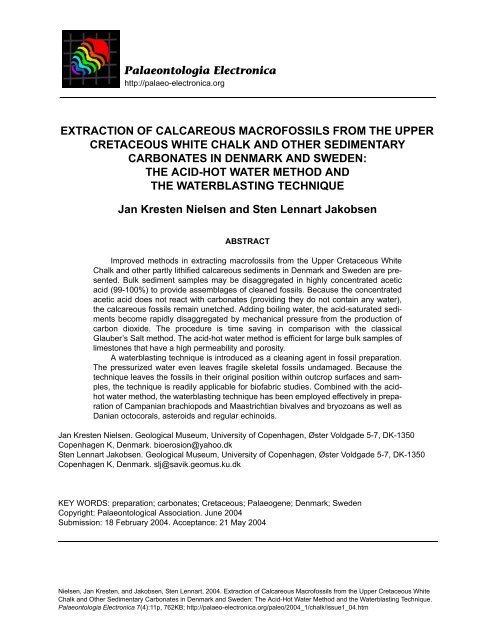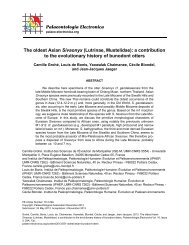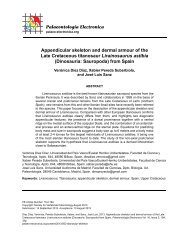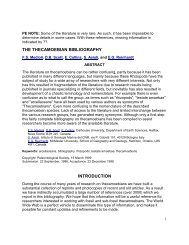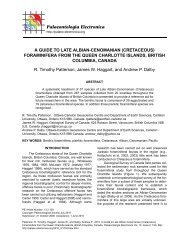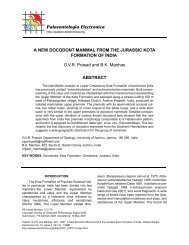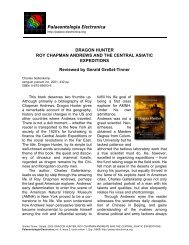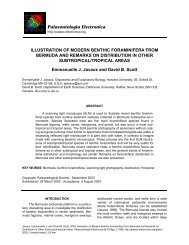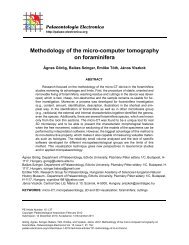Extraction of Calcareous Macrofossils from the Upper Cretaceous
Extraction of Calcareous Macrofossils from the Upper Cretaceous
Extraction of Calcareous Macrofossils from the Upper Cretaceous
You also want an ePaper? Increase the reach of your titles
YUMPU automatically turns print PDFs into web optimized ePapers that Google loves.
Palaeontologia Electronica<br />
http://palaeo-electronica.org<br />
EXTRACTION OF CALCAREOUS MACROFOSSILS FROM THE UPPER<br />
CRETACEOUS WHITE CHALK AND OTHER SEDIMENTARY<br />
CARBONATES IN DENMARK AND SWEDEN:<br />
THE ACID-HOT WATER METHOD AND<br />
THE WATERBLASTING TECHNIQUE<br />
Jan Kresten Nielsen and Sten Lennart Jakobsen<br />
ABSTRACT<br />
Improved methods in extracting macr<strong>of</strong>ossils <strong>from</strong> <strong>the</strong> <strong>Upper</strong> <strong>Cretaceous</strong> White<br />
Chalk and o<strong>the</strong>r partly lithified calcareous sediments in Denmark and Sweden are presented.<br />
Bulk sediment samples may be disaggregated in highly concentrated acetic<br />
acid (99-100%) to provide assemblages <strong>of</strong> cleaned fossils. Because <strong>the</strong> concentrated<br />
acetic acid does not react with carbonates (providing <strong>the</strong>y do not contain any water),<br />
<strong>the</strong> calcareous fossils remain unetched. Adding boiling water, <strong>the</strong> acid-saturated sediments<br />
become rapidly disaggregated by mechanical pressure <strong>from</strong> <strong>the</strong> production <strong>of</strong><br />
carbon dioxide. The procedure is time saving in comparison with <strong>the</strong> classical<br />
Glauber’s Salt method. The acid-hot water method is efficient for large bulk samples <strong>of</strong><br />
limestones that have a high permeability and porosity.<br />
A waterblasting technique is introduced as a cleaning agent in fossil preparation.<br />
The pressurized water even leaves fragile skeletal fossils undamaged. Because <strong>the</strong><br />
technique leaves <strong>the</strong> fossils in <strong>the</strong>ir original position within outcrop surfaces and samples,<br />
<strong>the</strong> technique is readily applicable for bi<strong>of</strong>abric studies. Combined with <strong>the</strong> acidhot<br />
water method, <strong>the</strong> waterblasting technique has been employed effectively in preparation<br />
<strong>of</strong> Campanian brachiopods and Maastrichtian bivalves and bryozoans as well as<br />
Danian octocorals, asteroids and regular echinoids.<br />
Jan Kresten Nielsen. Geological Museum, University <strong>of</strong> Copenhagen, Øster Voldgade 5-7, DK-1350<br />
Copenhagen K, Denmark. bioerosion@yahoo.dk<br />
Sten Lennart Jakobsen. Geological Museum, University <strong>of</strong> Copenhagen, Øster Voldgade 5-7, DK-1350<br />
Copenhagen K, Denmark. slj@savik.geomus.ku.dk<br />
KEY WORDS: preparation; carbonates; <strong>Cretaceous</strong>; Palaeogene; Denmark; Sweden<br />
Copyright: Palaeontological Association. June 2004<br />
Submission: 18 February 2004. Acceptance: 21 May 2004<br />
Nielsen, Jan Kresten, and Jakobsen, Sten Lennart, 2004. <strong>Extraction</strong> <strong>of</strong> <strong>Calcareous</strong> Macr<strong>of</strong>ossils <strong>from</strong> <strong>the</strong> <strong>Upper</strong> <strong>Cretaceous</strong> White<br />
Chalk and O<strong>the</strong>r Sedimentary Carbonates in Denmark and Sweden: The Acid-Hot Water Method and <strong>the</strong> Waterblasting Technique.<br />
Palaeontologia Electronica 7(4):11p, 762KB; http://palaeo-electronica.org/paleo/2004_1/chalk/issue1_04.htm
NIELSEN AND JAKOBSEN: FOSSILS IN HOT WATER<br />
INTRODUCTION<br />
<strong>Extraction</strong> <strong>of</strong> fossils <strong>from</strong> carbonates is<br />
affected by using different techniques depending<br />
on <strong>the</strong> composition and preservation <strong>of</strong> <strong>the</strong> fossils<br />
and <strong>the</strong> hardness <strong>of</strong> <strong>the</strong> enclosing sediment<br />
(matrix). Preparation consists <strong>of</strong> <strong>the</strong> following<br />
steps: 1) breaking up <strong>the</strong> sample (disaggregation)<br />
by chemical and physical means; 2) removing <strong>the</strong><br />
fine fraction through sieving; 3) drying <strong>the</strong> residue;<br />
and 4) hand-picking <strong>the</strong> fossils. The harder <strong>the</strong><br />
sample is, <strong>the</strong> harsher <strong>the</strong> preparation treatment<br />
required (Green 2001). For uncemented, slightly<br />
consolidated sediments, treatment by wet sieving<br />
is generally sufficient. If <strong>the</strong> fossils are embedded<br />
in more firm sediments, such as chalk, sieving will<br />
be useless without proper pre-treatment. The sample<br />
must be subjected to a procedure <strong>of</strong> disaggregation<br />
(without damaging <strong>the</strong> fossils) prior to wet<br />
sieving. The simplest way <strong>of</strong> disaggregating indurated<br />
calcareous sediments, such as <strong>the</strong> <strong>Upper</strong><br />
<strong>Cretaceous</strong> White Chalk, is by saturating <strong>the</strong> samples<br />
with water and <strong>the</strong>n placing <strong>the</strong>m in a freezer.<br />
The formation <strong>of</strong> ice crystals in <strong>the</strong> pore system<br />
breaks up <strong>the</strong> matrix (Hanna and Church 1928;<br />
Pojeta and Balanc 1989). This freeze-thaw method<br />
can be repeated several times until <strong>the</strong> sediment<br />
(matrix) is fully disaggregated. Ano<strong>the</strong>r freeze-thaw<br />
method is Glauber’s Salt method (Na 2SO 4 10H 2O,<br />
hydrated sodium sulphate) that also requires repetition<br />
<strong>of</strong> <strong>the</strong> procedure to function properly (Surlyk<br />
1972).<br />
The purpose <strong>of</strong> this paper is to document <strong>the</strong><br />
combination <strong>of</strong> two methods that are more efficient<br />
and less time-consuming than freeze-thaw methods<br />
but have received little attention. These are<br />
called <strong>the</strong> acid-hot water method and <strong>the</strong> waterblasting<br />
technique. They have been applied separately<br />
and in combination on samples <strong>from</strong> two<br />
localities: Lower Campanian skeletal sands at Ivö<br />
Klack, Sweden; <strong>the</strong> Maastrichtian White Chalk at<br />
Stevns Chalk Quarry, Denmark; <strong>the</strong> Danian Bryozoan<br />
Limestone at <strong>the</strong> sea cliff Stevns Klint, Denmark;<br />
and <strong>the</strong> Danian Bryozoan Limestone at <strong>the</strong><br />
Fakse Limestone Quarry, Denmark.<br />
HISTORY OF CHEMICAL<br />
DISAGGREGATION METHODS<br />
One method <strong>of</strong> splitting up calcareous sediments<br />
is Glauber’s Salt method (Franke 1922;<br />
Wicher 1942; Herrig 1966; Surlyk 1972; Schmid<br />
1974; Wissing and Herrig 1999). Following an idea<br />
<strong>from</strong> A.G.W. van Riemsdyk, Harting (1866) introduced<br />
<strong>the</strong> use <strong>of</strong> a saturated solution <strong>of</strong> crystalline<br />
sodium sulphate as a substitute for ordinary water.<br />
The method, using a solution prepared at about<br />
40°C, was successfully used by Keilhack (1917)<br />
and Franke (1922) for extraction <strong>of</strong> foraminifers<br />
and o<strong>the</strong>r micr<strong>of</strong>ossils <strong>from</strong> chalk. The sodium sulphate<br />
crystals grow in <strong>the</strong> pore system initiated by<br />
placing <strong>the</strong> samples in a deep freezer (or a watercooled<br />
container), and was an improvement in <strong>the</strong><br />
water-based freeze-thaw process and decreased<br />
<strong>the</strong> cycles <strong>of</strong> treatment to 16 to 18 times (Wicher<br />
1942; Surlyk 1972). Moreover, Wicher (1942) modified<br />
<strong>the</strong> Glauber’s Salt method to involve heating<br />
<strong>of</strong> samples covered with anhydrous sodium sulphate<br />
and subsequent boiling in a concentrated<br />
solution <strong>of</strong> sodium sulphate. The method is<br />
destructive to <strong>the</strong> micr<strong>of</strong>ossils, and thus, Kirchner<br />
(1958; Green 2001) revised <strong>the</strong> method by maintaining<br />
<strong>the</strong> temperature <strong>of</strong> <strong>the</strong> solution below <strong>the</strong><br />
boiling point. Although still widely used, <strong>the</strong><br />
Glauber’s Salt method has some disadvantages:<br />
1) The samples have to be reduced to smaller<br />
pieces <strong>of</strong> walnut size prior to treatment with<br />
Glauber’s Salt; 2) The method is time consuming;<br />
3) The fossils are not generally free <strong>of</strong> adhering<br />
sediment particles, and <strong>the</strong>refore need to be<br />
cleaned in an ultrasonic bath.<br />
Non-calcareous fossils are usually extracted<br />
<strong>from</strong> chalk and limestones by dissolving <strong>the</strong> matrix<br />
with a solution <strong>of</strong> acetic acid (Reid 1958; Müller<br />
1962; Zankl 1965; Rudner 1972; Jeppsson et al.<br />
1985, 1999). Because this process destroys <strong>the</strong><br />
calcareous fossils, o<strong>the</strong>r methods must be used to<br />
extract such fossils. Improving <strong>the</strong> procedure by<br />
Bourdon (1956; 1962; Lethiers and Crasquin-<br />
Soleau 1988), Nötzold (1965) described a method<br />
for disaggregating calcareous and clayey calcareous<br />
sediments used to extract charophytes and<br />
gyrogonites. A sample is submerged partly (2/3) in<br />
a solution <strong>of</strong> 96% acetic acid (CH 3COOH) and<br />
anhydrous copper II sulphate (CuSO 4 ) for 12 to 20<br />
hours. Then <strong>the</strong> sample is removed <strong>from</strong> <strong>the</strong> solution<br />
and covered by at least 10 litres <strong>of</strong> cold water.<br />
The formation <strong>of</strong> calcium acetate ((CH 3COO) 2Ca)<br />
and absorption <strong>of</strong> water within crystals leads to <strong>the</strong><br />
breakdown <strong>of</strong> <strong>the</strong> sample (Nötzold 1965; Hansch<br />
1994; Reich 1997; Wissing and Herrig 1999). The<br />
method requires <strong>the</strong> use <strong>of</strong> highly toxic components.<br />
Ano<strong>the</strong>r drawback is that fur<strong>the</strong>r treatment<br />
with hydrogen peroxide (H 2 O 2 ) may be required to<br />
clean fossils (Wissing and Herrig 1999). Our acidhot<br />
water method resembles a modified and much<br />
improved version <strong>of</strong> <strong>the</strong> method given by Nötzold<br />
(1965). However, <strong>the</strong>re is a fundamental difference:<br />
<strong>the</strong> disaggregation is caused by carbon dioxide<br />
formation and not crystal-bound water as in<br />
Nötzold’s (1965) method.<br />
2
NIELSEN AND JAKOBSEN: FOSSILS IN HOT WATER<br />
THE ACID-HOT WATER METHOD<br />
A faster and more efficient method for disaggregating<br />
coccolithic White Chalk is presented<br />
below. The method involves <strong>the</strong> use <strong>of</strong> concentrated<br />
acetic acid (99-100% pure acid) and must be<br />
employed with great care in a well-ventilated fume<br />
hood. Because <strong>the</strong> acetic acid does not completely<br />
dissociate into its component ions when dissolved<br />
in an aqueous solution, it is classified as a weak<br />
acid. A solution <strong>of</strong> acetic acid is a dynamic equilibrium<br />
between acetate ions (CH3COO- ), hydronium<br />
ions (H3O + ) and neutral molecules. The dissociation<br />
constant for acetic acid is 1.8 x 10-5 at 25°C.<br />
The essence <strong>of</strong> <strong>the</strong> method is that owing to <strong>the</strong> low<br />
dissociation, concentrated acetic acid, when<br />
applied to calcareous sediment, does not affect <strong>the</strong><br />
carbonate until mixed with water. The key step is to<br />
cover acid-saturated samples with plenty <strong>of</strong> boiling<br />
water. This may subsequently lead to complete disaggregation<br />
<strong>of</strong> <strong>the</strong> samples. Accordingly, <strong>the</strong><br />
method described here involves <strong>the</strong> use <strong>of</strong> concentrated<br />
acetic acid prior to disaggregation in boiling<br />
water.<br />
The White Chalk samples used in our experiment<br />
are 60 x 60 x 60 mm in size and weigh about<br />
190 g. The samples must be thoroughly dried overnight<br />
in a ventilated oven prior to immersion in<br />
acid. To avoid hardening <strong>of</strong> <strong>the</strong> sediment, <strong>the</strong> temperature<br />
should be less than about 50°C. After<br />
soaking for 40 minutes (normally sufficient for a<br />
complete saturation <strong>of</strong> <strong>the</strong> sample), <strong>the</strong> acid is<br />
decanted, and <strong>the</strong> sample is covered with boiling<br />
water containing a buffer solution <strong>of</strong> sodium carbonate<br />
(i.e., soda ash). When <strong>the</strong> acid is mixed<br />
with <strong>the</strong> water, an immediate chemical reaction<br />
takes place. The formation <strong>of</strong> carbon dioxide<br />
causes breakdown <strong>of</strong> <strong>the</strong> sample into finer particles.<br />
Although some <strong>of</strong> <strong>the</strong> fossils may be damaged<br />
during this process, sedimentary rocks<br />
generally disaggregate at <strong>the</strong>ir weakest points,<br />
which are <strong>the</strong> contacts between <strong>the</strong> fossils and <strong>the</strong><br />
matrix. After 30 minutes, <strong>the</strong> sample is almost<br />
entirely broken down and can be sieved through a<br />
set <strong>of</strong> mesh screens that retain <strong>the</strong> larger fossils<br />
and o<strong>the</strong>r particles. The residue is now thoroughly<br />
washed in cold running water. The fossil rich residue<br />
consisting mostly <strong>of</strong> foraminifers, ostracods,<br />
brachiopods and remains <strong>of</strong> larger biogenic fragments,<br />
is oven dried at 90°C.<br />
The dried residue is covered with concentrated<br />
acetic acid until saturated. Treatment is<br />
renewed with <strong>the</strong> addition <strong>of</strong> boiling water containing<br />
a buffered solution <strong>of</strong> sodium carbonate<br />
(Na2CO3 ) in order to keep <strong>the</strong> solution neutral. A<br />
few minutes later, <strong>the</strong> residue is entirely disaggre-<br />
gated by <strong>the</strong> action <strong>of</strong> carbon dioxide formation.<br />
After this second treatment, <strong>the</strong> residue is washed<br />
in cold water and separated into different size fractions.<br />
Although <strong>the</strong> formation <strong>of</strong> carbon dioxide<br />
implies etching <strong>of</strong> carbonate, <strong>the</strong> fossils are free <strong>of</strong><br />
dissolution features at 40x magnification. The<br />
extent <strong>of</strong> etching on micr<strong>of</strong>ossils and nann<strong>of</strong>ossils<br />
remains to be examined.<br />
Safety notice: as <strong>the</strong> fluid and vapour <strong>of</strong> concentrated<br />
acetic acid are toxic, <strong>the</strong> method may be<br />
hazardous. The procedure should be carried out<br />
within a fume hood. Because concentrated acetic<br />
acid is very corrosive and can cause painful burns,<br />
safety gloves and glasses must be worn.<br />
HISTORY OF BLASTING TECHNIQUES<br />
One <strong>of</strong> <strong>the</strong> basic requirements for studying<br />
fossils is to remove obscuring matrix. Various<br />
mechanical methods for surface cleaning include<br />
tools such as hammer and chisels, air-operated<br />
tools such as air scribes, rotary grinders, wire<br />
brushing, ultrasonic cleaning and sandblasting (air<br />
abrasive). The earliest record <strong>of</strong> sandblasting utilized<br />
in palaeontology dates back to <strong>the</strong> 1890s. At<br />
that time existing commercial sandblasting equipment<br />
was not designed for palaeontological work.<br />
In his study <strong>of</strong> Wenlockian trilobites, Bernard<br />
(1894) tried to remove <strong>the</strong> matrix <strong>of</strong> <strong>the</strong>ir underside<br />
in order to reveal hidden appendages. As <strong>the</strong> marly<br />
limestone was unfavourable for preservation, <strong>the</strong><br />
attempt was unsuccessful. Toge<strong>the</strong>r with W.I. Last<br />
(South Kensington Museum), however, Bernard<br />
(1894) succeeded in constructing a tool for future<br />
applications in palaeontology. Despite <strong>the</strong> usefulness<br />
<strong>of</strong> this cleaning equipment for fossils, <strong>the</strong> popularisation<br />
<strong>of</strong> <strong>the</strong> sandblasting technique first came<br />
with <strong>the</strong> development <strong>of</strong> <strong>the</strong> micro sandblaster for<br />
use in dentistry in <strong>the</strong> late 1940s (Osborn 1904).<br />
The micro sandblaster was marketed as Airdent by<br />
<strong>the</strong> firm S.S. White. However, it was not until <strong>the</strong><br />
1960s that <strong>the</strong> sandblasting technique was re-introduced<br />
in preparation laboratories and subsequently<br />
led to a wide range <strong>of</strong> applications in<br />
palaeontological research (e.g., Stucker 1961;<br />
Spreng 1962; Stucker et al. 1965; Aichinger 1969;<br />
Kuhn-Schnyder 1969; Lanooy 1970; Rensberger<br />
1971; Gun<strong>the</strong>r et al. 1979; Lörcher 1984; Hannibal<br />
et al. 1988; Hannibal 1989).<br />
The use <strong>of</strong> high-pressurized water, known as<br />
waterblasting, is a common industrial procedure for<br />
removing stubborn deposits such as paint and rust,<br />
<strong>from</strong> various kinds <strong>of</strong> surface materials. The waterblasting<br />
technology has been known for about 30<br />
years, but has so far only been used in palaeontology<br />
on a limited scale by Jakobsen (2003). By<br />
3
NIELSEN AND JAKOBSEN: FOSSILS IN HOT WATER<br />
blasting, <strong>the</strong> water creates an abrasive spray that<br />
is as effective, but not as damaging, as sandblasting.<br />
The waterblasting technology <strong>of</strong>fers a new<br />
option in mechanical treatment <strong>of</strong> fossils.<br />
THE WATERBLASTING TECHNIQUE<br />
The waterblasting process delivers water as<br />
an abrasive material under high pressure. By using<br />
an ordinary pressure washer (Alto Dynamic X-tra,<br />
Kew Technology, Type P406) with adjustable water<br />
pressure up to 150 bars, surfaces <strong>of</strong> uncemented<br />
and weakly cemented sedimentary carbonates are<br />
cleaned rapidly with outstanding results. Different<br />
nozzles can be mounted onto <strong>the</strong> pressure washer.<br />
Some nozzles fan out <strong>the</strong> water to cover a wide<br />
area resulting in a gentle cutting action. The angle<br />
<strong>of</strong> spray should be kept at 90 degrees to avoid<br />
grooves within <strong>the</strong> sediment surface. By moving<br />
<strong>the</strong> nozzle back and forth over a surface, matrix is<br />
removed and macr<strong>of</strong>ossils may be exposed in situ.<br />
O<strong>the</strong>r nozzles have tight spray patterns suitable<br />
for deep cutting. Prolonged cleaning <strong>of</strong> <strong>the</strong><br />
samples can result in a complete disintegration <strong>of</strong><br />
<strong>the</strong> sediment, so <strong>the</strong> fossil remains can be<br />
extracted for study without any evidence <strong>of</strong> abrasion.<br />
Cutting by <strong>the</strong> pressure washer can be varied<br />
by adjusting <strong>the</strong> water pressure, thus raising or<br />
lowering <strong>the</strong> velocity <strong>of</strong> <strong>the</strong> water stream, or by<br />
changing nozzles, thus altering <strong>the</strong> spray pattern <strong>of</strong><br />
water emitted.<br />
Subtle cleaning <strong>of</strong> macr<strong>of</strong>ossils may require<br />
lower water pressure than provided by <strong>the</strong> ordinary<br />
pressure washers. This type <strong>of</strong> cleaning may be<br />
facilitated by using a hand-held watergun (Wagner<br />
Model W 400 SE) with adjustable water pressure<br />
up to 180 bars at 10 mm <strong>from</strong> its orifice. For even<br />
more delicate cleaning, <strong>the</strong> Paasche airbrush<br />
(Model VL #3; http://www.paascheairbrush.com) is<br />
useful because <strong>of</strong> its smaller size when delivering a<br />
water stream at about 8 bars. By adding carborundum<br />
powder (1000 grit) to <strong>the</strong> water, <strong>the</strong> effect <strong>of</strong><br />
blasting may be increased by a factor 10 to 20.<br />
Adding a few drops <strong>of</strong> detergent may ease <strong>the</strong> suspension<br />
<strong>of</strong> <strong>the</strong> powder. Because <strong>the</strong> suspended<br />
powder is covered by a water film, <strong>the</strong> technique is<br />
much less abrasive than sandblasting. The water<br />
film functions like a cushion around <strong>the</strong> powder<br />
grains.<br />
Safety notice: never point <strong>the</strong> blasting equipment<br />
toward people. Safety glasses and gloves<br />
must be worn. The sample should be secured<br />
tightly before blasting.<br />
EXAMPLES<br />
Because no single tool or method is universally<br />
suitable for preparing fossils, <strong>the</strong> initial step in<br />
any preparation is to consider <strong>the</strong> best choice <strong>of</strong><br />
method. A combination <strong>of</strong> different methods may<br />
work best. Treatment <strong>of</strong> calcitic encrustations such<br />
as worm tubes and bryozoans with gentle waterblasting<br />
and <strong>the</strong> acid-hot water method may provide<br />
fur<strong>the</strong>r information about <strong>the</strong> fossil record.<br />
Prepared fossils are deposited in <strong>the</strong> Geological<br />
Museum, University <strong>of</strong> Copenhagen (DK and GM<br />
numbers).<br />
Danian octocorals <strong>from</strong> <strong>the</strong><br />
Fakse Limestone Quarry, Zealand, Denmark<br />
Toge<strong>the</strong>r with <strong>the</strong> Stevns Klint section, <strong>the</strong><br />
Fakse Limestone Quarry constitutes <strong>the</strong> type locality<br />
<strong>of</strong> <strong>the</strong> Danian Stage, which is <strong>the</strong> lowermost<br />
stage <strong>of</strong> <strong>the</strong> Paleogene. At Fakse, <strong>the</strong> Bryozoan<br />
Limestone is interbedded with Coral Limestone<br />
within a large coral-bryozoan mound complex (Floris<br />
1980; Willumsen 1995; Surlyk 1997). The Bryozoan<br />
Limestone contains abundant octocorals in<br />
places. Surfaces <strong>of</strong> blocks containing <strong>the</strong> octocoral,<br />
Moltkia isis Steenstrup, 1847, were cleaned<br />
by <strong>the</strong> large-scale waterblasting technique (Figures<br />
1, 2). To remove <strong>the</strong> matrix surrounding <strong>the</strong> octocorals,<br />
an ordinary pressure washer (Alto Dynamic<br />
X-tra, Kew Technology) was applied.<br />
Lower Campanian brachiopods <strong>from</strong><br />
Ivö Klack, Scania, Sweden<br />
Marine skeletal sands, which may be characterised<br />
as shell banks consisting in <strong>the</strong> main <strong>of</strong><br />
oysters and o<strong>the</strong>r sessile bivalves, occur on <strong>the</strong><br />
Swedish island Ivö Klack. An uppermost Lower<br />
Campanian age is indicated by belemnites (Christensen<br />
1975). Large specimens <strong>of</strong> <strong>the</strong> inarticulate<br />
brachiopod Crania stobaei Lundgren, 1885 (up to<br />
30 mm in size) are common within <strong>the</strong> sands. The<br />
shells <strong>of</strong> C. stobaei are usually filled with consolidated<br />
sediment that covers internal morphological<br />
features such as muscle scars. Clearing by using<br />
air scribes, scrapers and o<strong>the</strong>r mechanical aids<br />
has hi<strong>the</strong>rto been <strong>the</strong> only way <strong>of</strong> exposing <strong>the</strong><br />
inner shell surfaces. Preparation by combining <strong>the</strong><br />
acid-hot water method and waterblasting has produced<br />
fine results, even over short time periods<br />
(Figures 3, 4).<br />
Procedure:<br />
1. Before preparation, <strong>the</strong> specimen must be<br />
impregnated with a suitable lacquer on <strong>the</strong><br />
outer shell surface. O<strong>the</strong>rwise, <strong>the</strong> thin shells<br />
disintegrate during processing. When <strong>the</strong> lac-<br />
4
NIELSEN AND JAKOBSEN: FOSSILS IN HOT WATER<br />
Figure 1. Large-scale waterblasting <strong>of</strong> an exposure <strong>of</strong> <strong>the</strong> Middle Danian Bryozoan Limestone, Fakse Limestone<br />
Quarry, Denmark. 1. The angle <strong>of</strong> spray is maintained at 90 degrees. 2. The waterblasting creates rapid artificial<br />
wea<strong>the</strong>ring exposing numerous bryozoans and octocorals (Moltkia isis) (arrows). To <strong>the</strong> left untreated Bryozoan<br />
Limestone is seen. Scale on <strong>the</strong> folding rule is in cm.<br />
quer is dry, <strong>the</strong> specimen is treated with concentrated<br />
acetic acid.<br />
2. Concentrated acetic acid is poured over <strong>the</strong><br />
specimen. A wash bottle may be used to<br />
apply <strong>the</strong> acid locally on matrix. Application <strong>of</strong><br />
acetic acid should be done repeatedly until<br />
<strong>the</strong> matrix has absorbed sufficient acid.<br />
3. After 10 minutes, <strong>the</strong> acid-treated specimen is<br />
transferred to a container <strong>of</strong> suitable size, and<br />
plenty <strong>of</strong> boiling water is poured over <strong>the</strong><br />
specimen. A vigorous effervescence <strong>of</strong> carbon<br />
dioxide is caused by <strong>the</strong> mixture <strong>of</strong> <strong>the</strong><br />
acid and <strong>the</strong> water. When bubbles <strong>of</strong> carbon<br />
dioxide can no longer be observed in <strong>the</strong> solution<br />
(about 20 to 30 minutes), <strong>the</strong> specimen is<br />
removed and cleaned with a Wagner watergun<br />
at maximum working pressure. The treatment<br />
with acid and boiling water s<strong>of</strong>tens <strong>the</strong><br />
matrix, allowing high-pressure washing to<br />
completely remove it.<br />
4. The specimen is <strong>the</strong>n carefully washed in<br />
water to avoid <strong>the</strong> formation <strong>of</strong> calcium acetate<br />
crystals, which may be destructive. The<br />
specimen is <strong>the</strong>n dried in an oven for about<br />
three hours at 50°C.<br />
5. The procedure is repeated until all matrix is<br />
removed. The specimen illustrated in Figure 4<br />
had two treatments following <strong>the</strong> described<br />
procedure (Figure 4.1-4.3). The complete process<br />
took about six hours.<br />
Remarks: Boiling water may damage shells by<br />
exploiting pre-existing shell weaknesses. These<br />
weaknesses probably originate <strong>from</strong> earlier sediment<br />
compaction, and <strong>the</strong> treatment may exacerbate<br />
<strong>the</strong>m.<br />
Middle Danian echinoderms <strong>from</strong><br />
Stevns Klint, Zealand, Denmark<br />
Bryozoan wackestone and packstone mounds<br />
are well exposed within <strong>the</strong> Stevns Klint section,<br />
Zealand (Surlyk 1997; Surlyk and Håkansson<br />
1999). The mounds, which are Danian in age, consist<br />
<strong>of</strong> fragmented bryozoans within chalk-like<br />
debris <strong>of</strong> coccoliths, thoracospheres, foraminifers<br />
and invertebrate shells. Brachiopods, serpulids,<br />
echinoids, crinoids and octocorals are common<br />
(Surlyk 1997). Recently, a complete specimen <strong>of</strong><br />
<strong>the</strong> asteroid, Metopaster kagstrupensis Brünnich<br />
Nielsen, 1943, was collected <strong>from</strong> Middle Danian<br />
wackestone at Stevns Klint. The specimen needed<br />
preparation to uncover morphological features <strong>of</strong><br />
<strong>the</strong> obscured side <strong>of</strong> <strong>the</strong> asteroid (Figure 5).<br />
5
NIELSEN AND JAKOBSEN: FOSSILS IN HOT WATER<br />
Figure 2. The result <strong>of</strong> large-scale waterblasting <strong>of</strong> a block <strong>of</strong> Danian chalky limestone, Fakse Limestone Quarry.<br />
Sample GM 2004.919. 1. Bedding plane with abundant octocorals and oysters. The cleaning took about one minute.<br />
Scale bar 150 mm. 2. Close-up <strong>of</strong> a large oyster with scattered encrustations <strong>of</strong> cheliostomate bryozoans and single<br />
serpulids. Scale bar 25 mm. 3. Fur<strong>the</strong>r close-up section <strong>of</strong> <strong>the</strong> oyster showing that <strong>the</strong> waterblasting provides a superior<br />
cleaning effect without harming encrustations and boring openings (Entobia isp.). Scale bar 5 mm. 4. Close-up <strong>of</strong><br />
numerous fragmented stems <strong>of</strong> octocorals and a fragment <strong>of</strong> an echinoid test, Cidaris sp. (arrow). Scale bar 20 mm.<br />
5. Fur<strong>the</strong>r close-up <strong>of</strong> <strong>the</strong> echinoid and <strong>the</strong> octocorals. The octocorals have been heavily bioeroded by Cliona<br />
sponges. Scale bar 2 mm.<br />
Figure 3. The Wagner watergun, suitable for mediumscale<br />
waterblasting.<br />
Procedure:<br />
1. The preparation <strong>of</strong> <strong>the</strong> asteroid was more<br />
complex than <strong>the</strong> cleaning <strong>of</strong> inarticulate brachiopods.<br />
The specimen and <strong>the</strong> enclosed<br />
matrix were pre-treated with Synocryl 9122x<br />
(acryl-polymer) (Cray Valley Products Ltd.,<br />
http://www.crayvalley.com/) to withstand possible<br />
disaggregation.<br />
2. Additional streng<strong>the</strong>ning <strong>of</strong> <strong>the</strong> specimen was<br />
obtained by covering one side <strong>of</strong> <strong>the</strong> specimen<br />
with plaster <strong>of</strong> Paris (Figure 5.2). The<br />
plaster jacket provided a base against which<br />
<strong>the</strong> uncovered side could be cleaned without<br />
breaking <strong>the</strong> skeletal plates (Pojeta and Balanc<br />
1989).<br />
3. To loosen <strong>the</strong> matrix covering <strong>the</strong> specimen,<br />
concentrated acetic acid and boiling water<br />
were applied locally. Then <strong>the</strong> specimen was<br />
dried overnight at 50°C. The acid-hot water<br />
method was repeated four times (Figure 5.3-<br />
5.6).<br />
4. After cleaning, <strong>the</strong> plaster jacket was removed<br />
mechanically, and <strong>the</strong> underside <strong>of</strong> <strong>the</strong> specimen<br />
became visible (Figure 5.7). The duration<br />
<strong>of</strong> <strong>the</strong> preparation was about two hours. In<br />
similar cases, hydrated tri-sodium citrate<br />
(Na3C6H5O7 2H2O) may be used to break<br />
down <strong>the</strong> plaster <strong>of</strong> Paris (Pojeta and Balanc<br />
1989).<br />
In addition, <strong>the</strong> Stevns Klint section yielded<br />
Middle Danian specimens <strong>of</strong> regular echinoids with<br />
attached skeletal plates. A regular echinoid recovered<br />
<strong>from</strong> <strong>the</strong> bryozoan wackestone was successfully<br />
prepared by <strong>the</strong> aims <strong>of</strong> needles and<br />
6
NIELSEN AND JAKOBSEN: FOSSILS IN HOT WATER<br />
Figure 4. Combined application <strong>of</strong> <strong>the</strong> acid-hot water method and medium-scale waterblasting technique (Wagner<br />
watergun). Lower Campanian inarticulate brachiopod, Crania stobaei, <strong>from</strong> Ivö Klack, Sweden. GM 2004.920. 1-3.<br />
Successive stages <strong>of</strong> removal <strong>of</strong> surface matrix. Scale bar 10 mm. 4. Close-up <strong>of</strong> encrustations <strong>of</strong> bryozoans and serpulids.<br />
Scale bar 5 mm. 5. Close-up <strong>of</strong> bryozoan colony. Scale bar 1 mm.<br />
Figure 5. Application <strong>of</strong> <strong>the</strong> acid-hot water method on an articulated asteroid, Metopaster kagstrupensis Brünnich<br />
Nielsen, 1943. The asteroid was recovered <strong>from</strong> <strong>the</strong> Middle Danian Bryozoan Limestone (Tylocidaris abildgaardi Biozone)<br />
at Stevns Klint, Denmark. DK 283. Scale bar 25 mm. 1. Dorsal side <strong>of</strong> M. kagstrupensis. 2. The specimen<br />
enclosed in plaster jacket before treatment with <strong>the</strong> acid-hot water method. 3-6. Successive stages in preparation. 7.<br />
Ventral side <strong>of</strong> <strong>the</strong> prepared asteroid, airbrushed with black ink prior to coating with ammonium chloride.<br />
7
NIELSEN AND JAKOBSEN: FOSSILS IN HOT WATER<br />
waterblasting technique (Figure 6). The Wagner<br />
watergun proved suitable for cleaning <strong>the</strong> specimen,<br />
which can be referred to Typocidaris danica<br />
Ravn, 1928. According to Smith and Jeffery<br />
(2000), T. danica is a junior synonym for Temnocidaris<br />
(Stereocidaris) arnaudi (Lambert 1909).<br />
Maastrichtian bivalves <strong>from</strong><br />
Stevns Chalk Quarry, Zealand, Denmark<br />
The <strong>Upper</strong> Maastrichtian White Chalk is well<br />
exposed at <strong>the</strong> Stevns Chalk Quarry, which is adjacent<br />
to Stevns Klint. Calcitic shells <strong>of</strong> bivalves are<br />
commonly well preserved within <strong>the</strong> White Chalk.<br />
Shells <strong>of</strong> different species were carefully prepared<br />
by <strong>the</strong> use <strong>of</strong> small-scale wetblasting with carborundum<br />
powder (Paasche airbrush) (Figures 7, 8).<br />
To avoid damage <strong>of</strong> <strong>the</strong> shells during preparation,<br />
<strong>the</strong>ir inner surfaces were embedded in epoxy<br />
(“Strong Epoxy, Rapid,” product no. 2806, company<br />
Casco). The preparation, which took a few<br />
minutes for each shell, revealed subtle details <strong>of</strong><br />
external morphological features such as radial ribs<br />
and scales. Encrustations <strong>of</strong> bryozoan colonies<br />
were also preserved unaffected by <strong>the</strong> wetblasting<br />
(Figure 8.6-8.7).<br />
CONCLUSION<br />
The main advantages <strong>of</strong> <strong>the</strong> acid-hot water<br />
method are: 1) A significant reduction <strong>of</strong> time compared<br />
to <strong>the</strong> Glauber’s Salt method; 2) Large-sized<br />
samples can be treated, which makes it easier to<br />
extract fossils <strong>from</strong> bulk samples; 3) Fossils are<br />
cleaned <strong>of</strong> adhering sediment particles, which<br />
Figure 6. Medium-scale waterblasting<br />
and needle preparation <strong>of</strong><br />
a regular echinoid, Stereocidaris<br />
sp., <strong>from</strong> <strong>the</strong> Middle Danian Bryozoan<br />
Limestone (Tylocidaris abildgaardi<br />
Biozone) at Kulsti Rende,<br />
Stevns Klint. GM 2004.921. Scale<br />
bar 10 mm. 1. Before preparation.<br />
2-5. Successive stages in preparation.<br />
Figure 7. The Paasche airbrush, suitable for smallscale<br />
wetblasting.<br />
makes <strong>the</strong> method more reliable within a quantitative<br />
analysis <strong>of</strong> <strong>the</strong> sediments; 4) The method is<br />
particularly useful in examining drill cores, which<br />
have obvious sample size limitations; 5) The<br />
method has numerous applications in both <strong>the</strong> field<br />
and <strong>the</strong> laboratory in combination with waterblasting<br />
cleaning.<br />
ACKNOWLEDGEMENTS<br />
A. Dhondt (Bruxelles), E. Håkansson (Copenhagen)<br />
and J. Jagt (Maastricht) are thanked for<br />
<strong>the</strong>ir taxonomic analysis <strong>of</strong> <strong>the</strong> bivalves, bryozoans<br />
and <strong>the</strong> echinoid, respectively. M. Madsen (Copenhagen)<br />
kindly helped us during fieldwork. We are<br />
grateful to R.G. Bromley (Copenhagen), N.-M.<br />
Hanken, J.K. Nielsen (Tromsø) and two anonymous<br />
reviewers for <strong>the</strong>ir constructive comments.<br />
8
NIELSEN AND JAKOBSEN: FOSSILS IN HOT WATER<br />
Figure 8. Small-scale wetblasting with carborundum powder (Paasche airbrush) <strong>of</strong> bivalves <strong>from</strong> <strong>the</strong> <strong>Upper</strong> Maastrichtian<br />
White Chalk at Stevns Chalk Quarry adjacent to Stevns Klint, Denmark. These calcitic bivalves may be<br />
encrusted by fragile bryozoans. 1. Merklinia variabilis (von Hagenov, 1842). The ornamentation <strong>of</strong> <strong>the</strong>ir outer shell surface<br />
is commonly covered by matrix. GM 2004.922. Scale bar 10 mm. 2. Merklinia variabilis, right valve. GM 1987.67.<br />
Scale bar 5 mm. 3. Mimachlamys cretosa (Defrance in Brongniart, 1822), right valve. GM 2004.923. Scale bar 5 mm.<br />
4. Dhondtichlamys pulchella (Nilsson, 1827), both valves. GM 2004.924. Scale bar 5 mm. 5. Paranomia sp. GM<br />
1987.53. Scale bar 5 mm. 6. Bryozoan colony, unknown taxon. Scale bar 2 mm. 7. Tricephalopora sp. Scale bar 2<br />
mm. 8. Dhondtichlamys campaniensis (d´Orbigny, 1847), right valve. GM 1987.71. Scale bar 5 mm. 9. Spondylus<br />
dutempleanus d´Orbigny, 1847, left valve. GM 2004.925. Scale bar 5 mm.<br />
REFERENCES<br />
Aichinger, J. 1969. Erfahrungen bei der Präparation von<br />
Fossilien mit einem verbesserten Sandstrahlgerät.<br />
Der Präparator, 15:7-10.<br />
Bernard, H.M. 1894. On <strong>the</strong> application <strong>of</strong> <strong>the</strong> sand-blast<br />
for <strong>the</strong> development <strong>of</strong> trilobites. Geological Magazine,<br />
1:553-557.<br />
Bourdon, M. 1956. Études micropaléontologiques; utilisation<br />
de l'acide acétique dans la desagrégation des<br />
roches dures. Revue de L’institut Français du<br />
Pétrole, 12:14-15.<br />
Bourdon, M. 1962. Méthode de dégagement des micr<strong>of</strong>ossiles<br />
par acétolyse à chaud. Compte Rendu Sommaire<br />
des Séances de la Société Géologique de<br />
France, 1962:267-268.<br />
Brongniart, A. 1822. Sur les Caractères Zoologiques des<br />
Formations, avec l'Application de ces Caractères à la<br />
Détermination de Quelques Terrains de Craie. Paris.<br />
Brünnich Nielsen, K. 1943. The asteroids <strong>of</strong> <strong>the</strong> Senonian<br />
and Danian deposits <strong>of</strong> Denmark. Det Kongelige<br />
Danske Videnskabernes Selskab, Biologiske Skrifter,<br />
2. Series, 5: 1-67.<br />
Christensen, W.K. 1975. <strong>Upper</strong> <strong>Cretaceous</strong> belemnites<br />
<strong>from</strong> <strong>the</strong> Kristianstad area in Scania. Fossils and<br />
Strata, 7:1-69.<br />
9
NIELSEN AND JAKOBSEN: FOSSILS IN HOT WATER<br />
d’Orbigny, A. 1847. Paléontologie Française. Descriptions<br />
des Mollusques et Rayonnes Fossiles. Terrains<br />
Crétacés. Masson, Paris.<br />
Floris, S. 1980. The coral banks <strong>of</strong> <strong>the</strong> Danian <strong>of</strong> Denmark.<br />
Acta Palaeontologica Polonica, 25:531-540.<br />
Franke, A. 1922. Die Präparation von Foraminiferen und<br />
anderen mikroskopischen Tierresten, p. 509-533. In<br />
Keilhack, K. (ed.), Lehrbuch der praktischen Geologie,<br />
Mineralogie, und Palaeontologie (fourth edition).<br />
Enke-Verlag, Stuttgart.<br />
Green, O.R. 2001. A Manual <strong>of</strong> Practical Laboratory and<br />
Field Techniques in Palaeobiology. Kluwer Academic<br />
Publishers, Dordrecht.<br />
Gun<strong>the</strong>r, L.F., Gun<strong>the</strong>r, V.G. and Rigby, J.K. 1979. An<br />
economical miniature sandblaster for preparation <strong>of</strong><br />
fossils. Journal <strong>of</strong> Paleontology, 53:506-507.<br />
Hagenow, F. von 1842. Monographie der Rügen’schen<br />
Kreide-Versteinerungen. III. Abteilung: Mollusken.<br />
Neues Jahrbuch für Mineralogie, Geognosie, Geologie<br />
und Petrefaktenkunde, 1842: 528-575.<br />
Hanna, C.D. and Church, C.C. 1928. Freezing and thawing<br />
to disintegrate shales. Journal <strong>of</strong> Paleontology,<br />
2:131.<br />
Hannibal, J.T. 1989. The air-abrasive technique, p. 227-<br />
236. In Feldmann, R.M., Chapman, R.E. and Hannibal,<br />
J.T. (eds.), Paleotechniques. The Paleontological<br />
Society, Special Publication, 4:1-358.<br />
Hannibal, J.T., Williams, M.E., and Jackson, G.L. 1988.<br />
An inexpensive source <strong>of</strong> dolomite powder for use<br />
with airbrassive units. Journal <strong>of</strong> Paleontology,<br />
62:316.<br />
Hansch, W. 1994. Eine Ruhigwasser-Taphozönose aus<br />
einem Wenlock-Geschiebe (Untersilur). Paläontologische<br />
Zeitschrift, Stuttgart, 68:117-144.<br />
Harting, P. 1866. Das Mikroskop. Theorie, Gebrauch,<br />
Geschichte und Gegenwärtiger Zustand Desselben.<br />
Vol. 2. Gebrauch des Mikroskopes und Behandlung<br />
mikroskopischer Objecte (second edition). Friedrich<br />
Vieweg und Sohn, Braunschweig.<br />
Herrig, E. 1966. Ostracoden aus der Weißen Schreibkreide<br />
(Unter-Maastricht) der Insel Rügen. Paläontologische<br />
Abhandlungen (A: Paläozoologie), 2:693-<br />
1024.<br />
Jakobsen, S.L. 2003. A new preparatory approach <strong>of</strong><br />
decapod and thoracican crustaceans <strong>from</strong> <strong>the</strong> Middle<br />
Danian at Fakse, Denmark. Contributions to Zoology,<br />
72:141-145.<br />
Jeppsson, L., Anehus, R., and Fredholm, D. 1999. The<br />
optimal acetate buffered acetic acid technique for<br />
extracting phosphatic fossils. Journal <strong>of</strong> Paleontology,<br />
73:964–972.<br />
Jeppsson, L., Fredholm, D., and Mattiasson, B. 1985.<br />
Acetic acid and phosphatic fossils - a warning. Journal<br />
<strong>of</strong> Paleontology, 59:952-956.<br />
Keilhack, K. 1917. Die Präparation von Diatomeen, p.<br />
428-446. In Keilhack, K. (ed.), Lehrbuch der praktischen<br />
Geologie. Arbeits- und Untersuchungsmethoden<br />
auf dem Gebiete der Geologie, Mineralogie und<br />
Palaeontologie (third edition, vol. 2). Verlag Von Ferdinand<br />
Enke, Stuttgart.<br />
Kirchner, Z.M. 1958. A new method <strong>of</strong> hard-rock maceration.<br />
Micropaleontology, 4:327-328.<br />
Kuhn-Schnyder, E. 1969. Präparation von Fossilien mit<br />
dem Sandstrahlgerät. Naturwissenschaften, 56:293-<br />
295.<br />
Lambert, J. 1909. Révision de quelques Cidaridae de la<br />
Craie. Bulletin de la Société des Sciences Historiques<br />
et Naturelles de l’Yonne, 62 (1908): 113-<br />
175.<br />
Lanooy, R. 1970. Das ”Airbrasive” und einige seiner<br />
Anwendungsmöglichkeiten. Der Präparator, 16:47-<br />
54.<br />
Lethiers, F. and Crasquin-Soleau, S. 1988. Comment<br />
extraire les micr<strong>of</strong>ossiles a tests calcitiques des<br />
roches calcaires dures. Revue de Micropaléontologie,<br />
31:56-61.<br />
Lörcher, F. 1984. Erfahrungen bei der Lias-epsilon-Präparation<br />
mit der Sandstrahltechnik. Der Präparator,<br />
30:227-231.<br />
Lundgren, B. 1885. Undersökningar öfver Brachiopoderna<br />
i Sveriges Kritsystem. Lunds Universitets<br />
Årsskrift 20, Lund.<br />
Müller, K.J. 1962. Ein einfacher Behelf für die Lösungstechnik.<br />
Paläontologische Zeitschrift, Stuttgart,<br />
36:265-267.<br />
Nilsson, S. 1827. Petrificata Suecana Formationis Cretaceae,<br />
descripta et iconibus illustrata a S. N. Pars<br />
prior, vertebrata et mollusca sistens. Londini Gothorum.<br />
Nötzold, T. 1965. Die Präparation von Gyrogoniten und<br />
kalkigen Charophyten-Oogonien aus festen Kalksteinen.<br />
Monatsberichte der Deutschen Akademie<br />
der Wissenschaften zu Berlin, 7:216-221.<br />
Osborn, H.F. 1904. On <strong>the</strong> use <strong>of</strong> <strong>the</strong> sandblast in cleaning<br />
fossils. Science, new series, 19:256.<br />
Pojeta, J. Jr. and Balanc, M. 1989. Freezing and thawing<br />
<strong>of</strong> fossils, p. 223-226. In Feldmann, R.M., Chapman,<br />
R.E. and Hannibal, J.T. (eds.), Paleotechniques. The<br />
Paleontological Society, Special Publication, 4:1-358.<br />
Ravn, J.P.J. 1928. De regulære echinider i Danmarks<br />
kridtaflejringer. Det Kongelige Danske Videnskabernes<br />
Selskabs Skrifter, Naturvidenskabelig og<br />
Matematisk Afdeling, 9. Series, 1: 1-60.<br />
Reich, M. 1997. Fossile Holothurienreste (Echinodermata)<br />
aus Geschieben – ein Überblick, p. 81-89. In<br />
Zwanzig, M. and Löser, H. (eds.), Berliner Beiträge<br />
zur Geschiebeforschung. Cpress-Verlag, Dresden.<br />
Reid, R.E.H. 1958. A use for acetic acid in <strong>the</strong> study <strong>of</strong><br />
fossil sponges. Geological Magazine, 95:82-83.<br />
Rensberger, J.M. 1971. Rapid preparation <strong>of</strong> fossils by<br />
sandblasting. Curator, 14:109-122.<br />
Rudner, I. 1972. Preparing fossils with acid – a step-bystep<br />
account. Curator, 15:121-130.<br />
Schmid, F. 1974. Die präparativen Voraussetzungen für<br />
paläontologische Arbeiten an Fossilien aus der<br />
Schreibkreide. Der Präparator, 20:9-22.<br />
Smith, A.B. and Jeffery, C.H. 2000. Maastrichtian and<br />
Palaeocene echinoids; a key to world faunas. Special<br />
Papers in Palaeontology, 63:1-406.<br />
Spreng, A.C. 1962. Airbrasive cleaning tool. Journal <strong>of</strong><br />
Paleontology, 36:1391-1392.<br />
10
NIELSEN AND JAKOBSEN: FOSSILS IN HOT WATER<br />
Steenstrup, J. 1847. Ueber Korallen in der Faxöer Kreide,<br />
Moltkia und Cyathidium. Amtlicher Bericht über<br />
die 24. Versammlung Deutscher Naturforscher und<br />
Aertze in Kiel im September 1846, 148-150.<br />
Stucker, G.F. 1961. Salvaging fossils by jet. Curator,<br />
4:332-340.<br />
Stucker, G.F., Galusha, M.J. and McKenna, M.C. 1965.<br />
Removing matrix <strong>from</strong> fossils by miniature sandblasting,<br />
p. 273-275. In Kummel, B. and Raup, D. (eds.),<br />
Handbook <strong>of</strong> Paleontological Techniques. W.H. Freeman<br />
and Co., San Francisco.<br />
Surlyk, F. 1972. Morphological adaptations and population<br />
structures <strong>of</strong> <strong>the</strong> Danish chalk brachiopods<br />
(Maastrichtian, <strong>Upper</strong> <strong>Cretaceous</strong>). Det Kongelige<br />
Danske Videnskabernes Selskab, Biologiske Skrifter,<br />
19 (2):1-57.<br />
Surlyk, F. 1997. A cool-water carbonate ramp with bryozoan<br />
mounds: Late <strong>Cretaceous</strong>-Danian <strong>of</strong> <strong>the</strong> Danish<br />
Basin, p. 293-307. In James, N.P. and Clarke, J.A.D.<br />
(eds.), Cool-Water Carbonates. SEPM Special Publications,<br />
56:1-440.<br />
Surlyk, F. and Håkansson, E. 1999. Maastrichtian and<br />
Danian strata in <strong>the</strong> sou<strong>the</strong>astern part <strong>of</strong> <strong>the</strong> Danish<br />
Basin, p. 29-58. In Pedersen, G.K. and Clemmensen,<br />
L.D. (eds.), Field Trip Guidebook. 19 th Regional<br />
Meeting <strong>of</strong> Sedimentology, IAS, August 24-26, 1999,<br />
Copenhagen.<br />
Wicher, C.A. 1942. Praktikum der angewandten Mikropaläontologie.<br />
Gebrüder Borntraeger, Berlin-Zehlendorf.<br />
Willumsen, M. 1995. Early lithification in Danian azooxan<strong>the</strong>llate<br />
scleractinian lithoherms, Faxe Quarry,<br />
Denmark. Beiträge zur Paläontologie, 20:123-131.<br />
Wissing, F.-N. and Herrig, E. 1999. Arbeitstechniken der<br />
Mikropaläontologie. Eine Einführung. Ferdinand<br />
Enke Verlag, Stuttgart.<br />
Zankl, H. 1965. Zur mikr<strong>of</strong>aunistischen Charakteristik<br />
des Dachsteinkalkes (Nor/Rät) mit Hilfe einer<br />
Lösungstechnik. Zeitschrift der Deutschen Geologischen<br />
Gesellschaft, 116: 549-567.<br />
11


